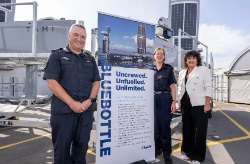Dumping Rubbish Will Continue To Hit Pockets
Old habits can be hard to break.
The public’s reliance on dumping their rubbish in landfills is going to become an increasingly expensive habit in years to come as the Government continues to use price hikes to persuade people to dump less and recycle, reduce and repurpose more.
The Council’s Assets & Services Committee has approved an across the board rise in landfill gate fees and an increase to the kerbside refuse collection targeted rate, all driven by Central Government increases in the waste disposal levy and emissions trading scheme. The updated waste fees and charges come into effect on 1 July.
Council’s Solid Waste Manager Alec McNeil said the Government introduced the waste disposal levy in 2008/2009.
“It was designed to send a price signal to the market that landfill disposal is the least desirable option for dealing with waste. The Government’s intention is to gradually increase the levy over a period of time and encourage reuse and recycling instead of people just dumping their waste. We are seeing the impact of this now,” he said.
The emissions trading scheme also impacts on the cost of disposal at landfill. “The landfill is an emitter of carbon dioxide and emissions are calculated and priced based on a tonnage rate applied to carbon,” said Alec.
Waste fees and charge are reviewed annually – this review takes into account:
- Contract cost escalation
- Waste disposal levy increases
- Carbon pricing
- Other costs related with operations
Bluegums landfill in Blenheim is Marlborough’s only mixed waste disposal point and is Council-owned, with its operating costs 100% recovered through user-pays gate fees. “Cost increases at the landfill affect everyone who disposes of rubbish,” said Alec.
The waste disposal levy is collected by the Council and transferred to Central Government. Marlborough receives just under half the levy back.
“It’s important to note that the money raised has to be reinvested in waste infrastructure and service provision to help reduce our reliance on landfill and encourage reduction, recycling and reuse.”
Since the waste disposal levy and carbon pricing were introduced, the Council has been able to invest in improving transfer stations to allow for recycling and establish facilities such as the resource recovery centre, e-waste collection facility, salvage yard, hazardous waste centre, waste sorting centre, rural community recycling containers, greenwaste acceptance facility and the reuse centre.
The Council also introduced kerbside recycling collections in Blenheim and Picton in 2010 to help reduce reliance on landfill and provide alternative methods for dealing with waste.
“It is time for people to make that change and not rely on sending their waste to landfill – it’s only going to get more expensive. It’s time to reduce, reuse, recycle and repurpose more than ever,” said Alec.
What do the changes mean?
Changes to what the community pays for waste will be dependent on the type and amount of waste people take to the transfer stations or landfill.
- The tonnage rate at landfill will increase by $21.82 per tonne (including GST) for all waste types;
- The average cost for disposing of general waste at the transfer stations or waste sorting centre will increase between $1 and $2 per visit;
- The average cost of kerbside side refuse bags will increase by $0.12 per bag or $6.24 per roll of 52;
- The average cost of grass disposal will increase by $2.50 per visit.
The new waste fees and charges will take effect from 1 July 2021 subject to ratification at the full Council meeting on 13 May.


 Gordon Campbell: On Why The US Stands To Lose The Tariff Wars
Gordon Campbell: On Why The US Stands To Lose The Tariff Wars Te Pāti Māori: Ngarewa-Packer - Fast-Tracking Seabed Mining Ignores Māori Opposition And Environmental Precedent
Te Pāti Māori: Ngarewa-Packer - Fast-Tracking Seabed Mining Ignores Māori Opposition And Environmental Precedent New Zealand Defence Force: Defence And Customs Strengthen Maritime Security With Uncrewed Surface Vessels
New Zealand Defence Force: Defence And Customs Strengthen Maritime Security With Uncrewed Surface Vessels SPCA: Huge Win With New Dog Tethering Regulations
SPCA: Huge Win With New Dog Tethering Regulations Community Housing Aotearoa: Ngā Wharerau o Aotearoa Says New Partnership Model Helping Ensure Right To A Decent Home Is Realised
Community Housing Aotearoa: Ngā Wharerau o Aotearoa Says New Partnership Model Helping Ensure Right To A Decent Home Is Realised Greenpeace Aotearoa: Babies At Risk Due To Nitrate-Contaminated Drinking Water In Ashburton District
Greenpeace Aotearoa: Babies At Risk Due To Nitrate-Contaminated Drinking Water In Ashburton District Driving Change Network: Response To Government’s Proposed Driver Licensing Changes
Driving Change Network: Response To Government’s Proposed Driver Licensing Changes


